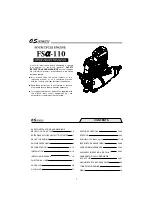
PRODUCT INFORMATION
INDEX
DATE
Dep. 2
IC-C-D-40-003e A
May 2012
OXIDATIVE CATALYTIC CONVERTERS
5/6
4. TECHNICAL LIMITATIONS OF THE LUBRICATING OIL
The lubricating oil used by an engine with an oxidative catalytic converter in the exhaust must have certain
special specifications with regard to maximum additive content and maximum engine consumption. This is
because both high specific consumption of motor oil and excessive additive levels therein can lead to the
excessive generation of components that are damaging to the catalytic converter, or poisons that reduce its
performance and useful life.
As well as these values, the lubricating oil must comply with specifications relating to engines that do not have
oxidative catalytic converters fitted to their exhausts.
POISON
MAXIMUM AMOUNT
Zinc
900 ppm
Phosphorous
400 ppm
Sulphated Ash
0.6% weight
Specific consumption
In accordance with
KOHLER
specification IO-G-M-25-001
Table 3. Limit of harmful compounds entering the catalytic converter in the engine lubricating oil.
5. TECHNICAL LIMITATIONS OF COMBUSTION GAS AND EXHAUST GAS
As with the lubricating oil, certain catalytic converter poisons can mix with the exhaust gas flow as a result of the
combustion of the fuel used. The maximum quantity of poison catalytic converters can tolerate, like their
performance, depend on the suppliers. By way of example, the following table shows the limits for these types of
harmful components for the approved catalytic converter.
POISON
LOCATION
MAXIMUM AMOUNT
Chlorine compounds
Combustion gas
According to fuel IP
IP IC-G-D-30-002
Sulphur
Combustion gas
According to fuel IP
IP IC-G-D-30-002
Silicon compounds
Combustion gas
Null for both types of fuel.
Calcium
Sulphur
Phosphorous
Zinc
Iron
PhosZinc+Iron
Catalytic substrate
< 1 %
< 1 %
< 1 %
< 0.5 %
<1 %
< 2 % (collectively).
Heavy metals: Pb, Hg, Ar, Sb, Zn, Cu, Sn, Fe,
Ba, Ni, Cr, P y S
Exhaust gas
200 ppm weight (collectively)
Ash deposit
Catalytic substrate
< 1g/litre of substrate
Table 4. Limit of harmful compounds entering the catalytic converter present in the engine's exhaust gases.
2.7.5
O&M_2.002211.810_A_10_2016
















































